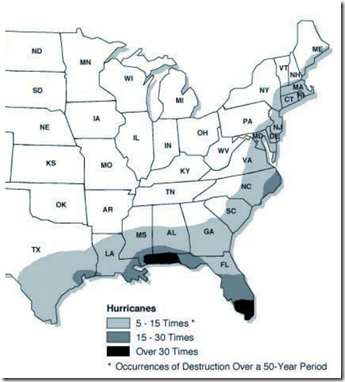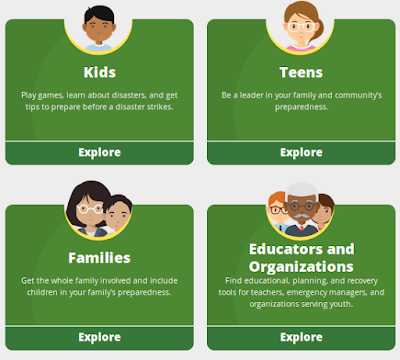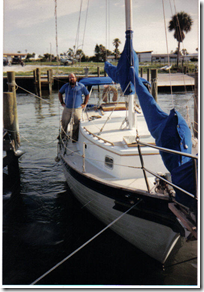
Note: September is National Preparedness Month. Follow this year’s campaign on Twitter by searching for the #NatlPrep #BeReady or #PrepMonth hashtags.
This month, as part of #NPM23, I’ll be rerunning some updated preparedness essays, along with some new ones
#17,659
For most people - whether it is due to an earthquake, a flood, or a hurricane - regional disasters can often boil down to days or weeks of unscheduled camping in your home, in a community shelter, or possibly in your backyard.
The power may be out, or intermittent. Potable water my be cut off. And many of the luxuries of modern living we take for granted - air conditioning, central heat, hot showers, and the Internet - may all be temporarily unavailable.
My `standard advice' is that everyone should strive to have the ability to withstand 7 to 10 days without power and water. Recommended preps include:
- A battery operated NWS Emergency Radio to find out what was going on, and to get vital instructions from emergency officials
- A decent first-aid kit, so that you can treat injuries
- Enough non-perishable food and water on hand to feed and hydrate your family (including pets) for the duration
- A way to provide light when the grid is down.
- A way to cook safely without electricity
- A way to purify or filter water
- A way to handle basic sanitation and waste disposal.
- A way to stay cool (fans) or warm when the power is out.
- A small supply of cash to use in case credit/debit machines are not working
- An emergency plan, including meeting places, emergency out-of-state contact numbers, a disaster buddy, and in case you must evacuate, a bug-out bag
- Spare supply of essential prescription medicines that you or your family may need
- A way to entertain yourself, or your kids, during a prolonged blackout
Because all of this takes a certain amount of preparation - 16 years ago I wrote a blog called Hickory Farms Will Hate Me For This - where I began promoting the idea that instead of gifting cheese platters, fruitcakes and ugly sweaters to friends and family, we should all be giving preparedness gifts for holidays, birthdays, and anniversaries.
I often find these gifts on sale in discount stores, bargain basements, and flea markets, and stock up whenever I come across a good deal. But it should be stressed that quality counts. You don't want your life to depend on a Dollar Store pocket knife.
Sometimes I make the gifts myself, as when several years back I cobbled together some first aid kits, and distributed them to a number of friends and relatives. You can either put one together yourself, or purchase one already assembled.

There is no substitute for having a well stocked first aid kit when you really need one. Having a kit isn't enough, however. Knowing what to do in an emergency is equally important.
Luckily there are a number of good first aid books available,
including:
When the lights go out, nothing beats having a couple of good LED flashlights or lanterns. And each year they get brighter, and cheaper. Most run between $5 and $10, and that beats the heck out of cursing the darkness.

High on the list of things to have is a way to make water potable.
Although (
unscented) bleach will work, it requires careful measuring, and imparts a taste to the water many dislike. An option that has gotten a lot less expensive in recent years are personal filtration systems, like the
LifeStraw ®.
At just 2 ounces, this personal water filter will reportedly filter 1000 liters down to .2 microns. Not bad for around $20. I've also added the Sawyer Mini-Filter to my preps, again about $20.

Speaking of water, having a way to store enough water for three days (
1 gal/person/day) is essential. A family of 4 will need at least 12 gallons for 72 hours. Personally, I keep enough on hand for a couple of weeks.
While there are plenty of `free options’ – like rinsed and recycled 2-liter plastic soda bottles or other food-safe plastic jugs – you can also buy collapsible 5 gallon containers.
A couple of years ago I bought several 5 gal. buckets (
with lids) from a home improvement store, along with mylar bags and oxygen absorbers from Amazon, and put together some long-term food storage buckets for friends.

Cost per bucket? About $30. But enough food to keep two people going for ten days or more in an emergency. I keep a couple on hand (
one for me, one for the cat), myself.
A few years back, however, I added some dehydrated/freeze dried foods (in #10 cans) to this culinary category, as they only require hot or boiling water to prepare.
While considerably pricier than buying staples like Ramen, rice and beans, they are more convenient. With a propane or butane camp stove or even a single burner Propane burner (
see below) and a couple of 1 pound gas cylinders (about $5 each) and you can cook for a week or longer. Typically, a 1lb cylinder proves 1.5 to 2.0 hours of cooking.

Every home should have a battery operated radio (
with NWS weather band), yet many do not. Some are available with crank or solar charging. In any event, you'll want something which can pick up the NOAA NWS Emergency Broadcaster in your region.

As I described earlier this summer (see
My Upgraded Solar Power System (2023 Edition), if you are even a little bit handy, it is a relatively easy cobble together a simple solar charging system.

No, you won’t keep the A/C or refrigerator running on a budget system, but you can keep your LED lantern batteries, cell phone, CPAP, iPod or iPad, or notebook computer running. Add a $20 inverter (converts 12 volt battery power to 120v AC), and you can do even more.

I've also purchased (
for myself, and some components for friends) some of `off-the-shelf' solar items, including fans, LED lanterns, several USB battery packs, and a 21 watt Solar panel (see
Some Simple Off-The-Shelf Solar Solutions For Power Outages)..
While my primary concern in Florida is staying cool during a summer power outage, in colder climes, staying warm can be a major concern. Sleeping bags, pop-up tents (
that can be used indoors or out), and propane or kerosene heaters can be lifesaving.
Something as simple, and as utilitarian, as a multi-function `Swiss’ army knife, a`Multi-tool’, a `plug in' auto 12 volt USB charger (
see below), or even multi packs of AA or AAA batteries, makes a great preparedness gift.

Often forgotten, but safety goggles, a box or two of vinyl or nitrile gloves, and a box of surgical face masks (or preferably N95 masks) should be in everyone’s emergency kit as well - whether you're dealing with a nasty flu season, COVID-19, or smoke from wildfires.

And while not necessarily lifesaving, having a way to occupy your mind (
or your kids) during an extended grid down situation can help maintain your sanity. Books, board games, and having good old-fashioned conversations are undoubtedly the best, but when they run dry having a low drain battery powered MP3 player, or a battery run DVD player, can seem like a lifesaver.

Admittedly, many of the items listed above are needed more for comfort and convenience, than for survival. But the physical and psychological impacts stemming from the hardships following a disaster are quite real (see
Post-Disaster Sequelae), and a modicum of creature comforts can go a long ways towards mitigating their effects.
FEMA, Ready.gov and a myriad of other state and national entities know the risks we face, and would like to see Americans adopt and embrace a culture of preparedness.
And we can do that for ourselves, our families, and our friends.
One gift at a time.











































